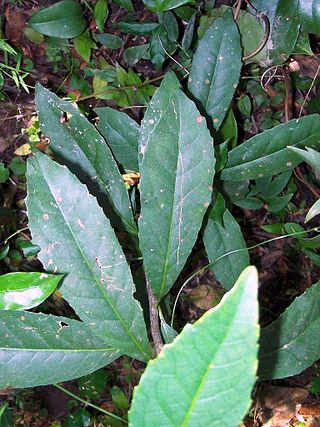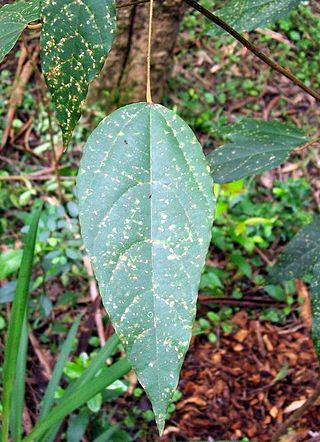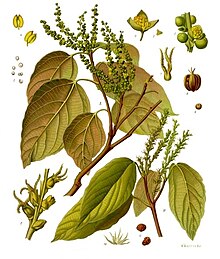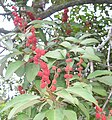
Karrabina benthamiana is a species of rainforest trees, growing naturally in north–eastern New South Wales and south–eastern Queensland, Australia. They have common names including red carabeen, leather jacket, brush mahogany, red bean, pink marara and brush mararie. This species used to be placed in the genus Geissois as Geissois benthamiana.

Homalanthus populifolius, the bleeding heart, native poplar or Queensland poplar, is an Australian rainforest plant in the family Euphorbiaceae. It often appears in areas of rainforest disturbance. Bleeding heart is highly regarded by rainforest regenerators because of its fast growth and use as a pioneer species in rainforest regeneration.

Hibiscus splendens, the splendid hibiscus, is a species of flowering shrub or tree in the mallow family, Malvaceae. Other common names include hollyhock tree and pink cottonwood. H. splendens is a fairly common plant native to eastern Australia. The range of natural distribution is from Wollongong in the state of New South Wales to Blackdown Tableland National Park in central east Queensland. The habitat is on clearings or disturbances around the margins of the drier rainforests.

Vitex lignum-vitae, known in Australia as yellow hollywood or "lignum-vitae", is a rainforest tree of eastern Australia. The natural range of distribution is in dry, sub-tropical or tropical rainforest from the Richmond River, New South Wales to Cape York Peninsula at the northernmost tip of Australia. It also occurs in New Guinea. Lignum vitae is Latin for "wood of life".

Symplocos thwaitesii, or the buff hazelwood, is a rainforest tree growing in eastern Australia. Seen in tropical, sub-tropical and warm temperate rainforests, often in gullies. Occasionally it grows in cooler situations such as at Monga National Park.

Claoxylon australe, known as brittlewood is a common rainforest shrub or understorey tree. Its habitat includes all types of eastern Australian rainforests. The natural range of distribution is from Eden in southeastern New South Wales to Bowen in tropical Queensland.

Daphnandra johnsonii, also known as the Illawarra socketwood, is a rare rainforest tree in the Illawarra district of eastern Australia.

Denhamia silvestris is a shrub or small tree growing from Picton, New South Wales to Kroombit Tops, near Gladstone, Queensland. It occurs in dry rainforest, eucalyptus and rainforest ecotone areas. Common names include narrow leaved orangebark, orange bush and orange bark.

Didymocheton muelleri, the red bean or Miva mahogany, is a rainforest tree in the family Meliaceae. It occurs in tropical, sub-tropical and littoral rainforests in eastern Australia, from the Bellinger River in New South Wales in the south, to the wet tropics of north-eastern Queensland. A signposted red bean tree may be seen near the car park of Victoria Park Nature Reserve in north-eastern New South Wales.

Elattostachys nervosa, known as the green tamarind or beetroot tree is a common rainforest tree of eastern Australia. Found in all types of rainforest, growing from Paterson, New South Wales in the south to Gympie in south east Queensland. The name Elattostachys refers to "little spikes", a flower feature of other plants in this genus. Nervosa refers to the prominent leaf venation. Beetroot Tree refers to the beetroot red leaves of the new growth.

Mallotus discolor is an Australian rainforest tree in the spurge family. It is known as the yellow kamala, due to the yellowish orange fruit covering, which produces a yellow dye.

Cyclophyllum longipetalum, known as the coast canthium is a shrub or tree occurring in eastern Australia. Commonly seen growing in a variety of different rainforest situations. It occurs from Lake Conjola in southern New South Wales to Fraser Island in southeastern Queensland.

Mischocarpus pyriformis, known as the pear fruited tamarind is a rainforest tree of eastern Australia. Occurring from Seal Rocks, New South Wales to as far north as Cooktown in tropical Queensland. The sub species found in New South Wales is Mischocarpus pyriformis subsp. pyriformis.

Baloghia marmorata is a rare rainforest plant of eastern Australia. It is commonly known as the marbled baloghia.

Endiandra introrsa is a rare rainforest tree growing in eastern Australia. Listed with a Rare or Threatened Australian Plants (ROTAP) rating of 3RCa. Its habitat is a warm temperate rainforest on the poorer rainforest soils, mostly over 300 metres in altitude, and its range of natural distribution is from near Dorrigo to various sites in the state of Queensland.

Pseudoweinmannia lachnocarpa is a rainforest tree of eastern Australia. Common names include rose marara, mararie, scrub rosewood and red carabeen. The species name lachnocarpa is from the Greek, referring to the "woolly fruit". The genus name refers to the similarity of another genus, Weinmannia, after the German eighteenth century pharmacist J.W. Weinmann.

Arytera distylis, known as the two-leaved coogera or twin-leaved coogera is a rainforest tree of eastern Australia. It grows by streams or in seaside rainforests. It occurs from the Orara River in the Mid North Coast region of New South Wales, extending up to Maryborough in southeast Queensland.

Mallotus claoxyloides is an Australian rainforest plant in the spurge family. Common names include green kamala, odour bush, and smell of the bush. Opinions are divided on the strong scent of the plant. Some say it is offensive and resembles a skunk while most others find the scent aromatic and delightful. Because of the scent, it is grown in gardens.

Elattostachys xylocarpa, known as the white tamarind or short-leaf beetroot is a common rainforest tree of eastern Australia. Found in the drier rainforests, which are based on volcanic soils. From as far south as the Orara River in northern New South Wales to Bowen in tropical Queensland. The name Elattostachys refers to "little spikes", a flower feature of other plants in this genus. xylocarpa refers to the hard woody fruit.

Quintinia verdonii, commonly known as the grey possumwood, is a tree of eastern Australia. It is mostly found in rainforests at high altitude. The range of natural distribution is between the Barrington Tops region of New South Wales and the Blackall Range in the state of Queensland.
























